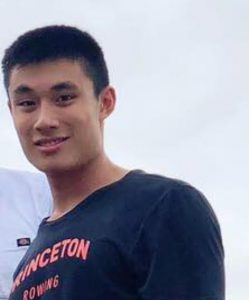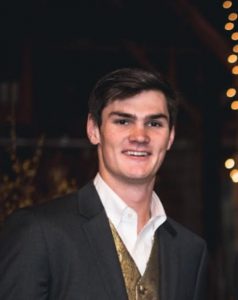Students Larry Bao ORFE, 2019 Hunter Johnson ORFE, 2019 Jonny Naylor Economics, 2019 Project Description After completing the first part of our project, a large coffee/poker table, the obvious next…
Hunter Johnson
ORFE, 2019
Jonny Naylor
Economics, 2019
Project Description
After completing the first part of our project, a large coffee/poker table, the obvious next step in our year long course was to make something that compliments our table; a set of poker chips. For the second half of the course, we decided to make 60 poker chips out of acrylic. There are three different designs for the chips to denote different chip values. Each of the three chip types are a different color of acrylic, and we used laser etching to etch our three faces onto the different denominational chips. We also made a personalized box to store the poker chips inside of. Using the Carvey® 3D carving machine, we were able to cut out each of the sides of the box while also including personalized designs on specific sides of the box. The poker chips and their carrying case relates to our personal interests because it has become a tradition every year for our team to play leisure poker during the spring racing season. We have now created an official poker chip set for the team that is customized to both Princeton (through the color scheme) and to our team (by having our faces etched on the chips as well as a team slogan carved into the exterior of the box).
Laser etching is a popular strategy for accurately depicting detailed designs on a variety of level surfaces. It is done by using a laser beam with high heat, which melts the surface. The material expands when this occurs, which in turn causes it to rise. This strategy is ideal for projects which require an artistic process to be repeated many times. In order to etch on our specific medium, acrylic, it is necessary to adjust the controls on the machine such that the laser strength is matched to the specific heat of acrylic. This adjustment allows for a high level of detail in the etchings. Using the Universal® Laser Systems machine, the process of laser etching the same design on a large number of chips can be executed efficiently after creating a design within AutoCAD as a .dwg file.
The Universal® Laser Systems machine can also be utilized for repeatedly making exact cuts, which is a great resource for cutting out a large number of the same item, especially after etching. This feature allows for the etchings to be executed first, and then each etching can be cut out in identical 3.66cm radius acrylic chips. The laser cutter allows for a high level of accuracy, ensuring that each poker chip is identical. This process can be repeated with a different design, enabling the creation of three different types of chips while maintaining efficiency.
The Carvey® 3D carving machine is suited to producing wooden boxes. It is safe and accurate, and is ideal for projects whose students have little to no experience with CAD. This is due to the ease of use of its web-based software, Easel. The machine’s build area is sufficiently large for projects with no parts larger than 11.6”x8”x2.50”. The spindle allows for many sizes of milling bits, including 3/16”, 1/8“, 1/4“. Using the 1/8“ spindle to cut out the six faces of the box, including ridges on all sides to allow for the connections between each face, the Carvey® 3D carving machine enables a straightforward process for producing a box of our specified dimensions. The Carvey® 3D carving machine can also be used for producing detailed designs carved into wood, allowing us to customize the exterior of our box with carved designs.
(1) “Differences Between Laser Marking, Engraving and Etching.” TYKMA Electrox, 12 Feb. 2019, www.permanentmarking.com/what-are-the-differences-between-laser-marking-laser-engraving-and-laser-etching/.
(2) “Bring Carving into the Classroom.” Carvey®, www.inventables.com/technologies/carvey.
(3) “The Ultimate Guide to 3D Printing – 101 Questions Answered.” All3DP, 16 Nov. 2017, all3dp.com/3d-printing-3d-printer-guide-101-questions/.
During the first semester of the course we made a large poker/coffee table that had legs that could fold such that the table could be utilized at multiple heights. In order to do this, we used an 8 feet by 4 feet piece of cherry plywood for the tabletop, four 3 foot long 4 by 4s, four large hinges, and some scrap wood to construct a design for the surface. To construct the table, we first cut the 4 by 4s in half and sanded the edges such that we had two 1.5 foot long 4 by 4 pieces for each leg. Then we attached the hinges such that each leg could fold freely between 3 feet long and 1.5 feet long. We then used “L” supports and screws in order to attach the legs to the tabletop, such that the legs would fold outward, and then swing up so that they were parallel to their other half when the table was at its low height. This concluded the construction of the table, next was design. In order to make a design for the table, we used the Jigsaw to cut out the letters necessary to spell “HCREW” from some 1 inch thick scrap wood. We then used orange spray paint to color the letters, and dark gray stain to cover the tabletop. Once the stain had dried, we fastened the letters onto the tabletop using nails. The finished product can be seen in the finished product photos.
The fabrication process required a number of specific steps to reach our goal of creating a set of three different types of poker chips as well as box to store them in. The first step was to create the design for the box in Easel. In order to do this, we started by deciding on our specific dimensions such that all of the chips would fit nicely into the box. The dimensions for the box were 5in x 5in x 2 in. We used these dimensions to produce a design in Easel that would cut out the four 5in x 2in faces and two 5in x 5in faces of our box. We also wanted to include a personal touch by carving a design into the exterior of two of the 5in x 2in faces. Once we finished our design in Easel, we used the Carvey® 3D carving machine to execute our design on ¼ in thick wood. The final step in the creation of our box was to glue the edges together using wood glue and clamp them down to allow for even adhering. Once the glue had dried, we sanded down the edges of the box, including any excess glue that appeared on the exterior of the box. Finally, to bring some life to the exterior of our poker chip storage box, we colored in our designs on the exterior of the box. The final product, depicted in the images, is a perfect storage case for the set of poker chips that we made by following the process outlined below.
The next step in our project was to actually produce the poker chips. To do this, we first needed to settle on our designs for the three different chip denominations. We used Photoshop to create black and white etchable photos of each member of our project group. We then used AutoCAD to create three different designs for a sheet of 20 circular cut lines, each of which containing one of the three etchable photos. Each of the three sheets was a different chip design, allowing for the creation of three different sets of 20 identical chips. To ensure the order in which the machine would execute these designs, we made the cut lines a different color from the etchings. Using each .dwg design file we were able to utilize the Universal® Laser Systems machine to make our designs come to life. We used three different colors of acrylic, one for each chip design, and set up the machine for etching and cutting acrylic. To ensure the order of execution, we ran the etchings first for each design and then followed them with the circular cuts around each etching. The resulting chips required minor low grade sanding to remove any inconsistencies on specific chips. This process produced 60 poker chips with 20 of each of three different design types, one design for each of our three faces. The final product, depicted in the photos, is a set of personalized poker chips with a sturdy storage case to be passed down on our team for years to come.


